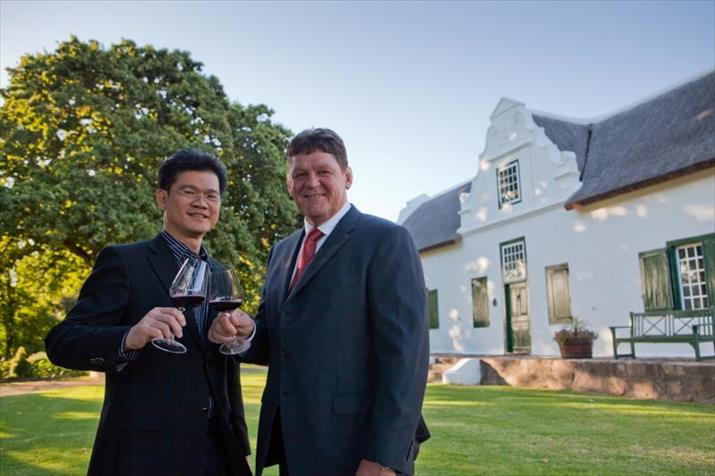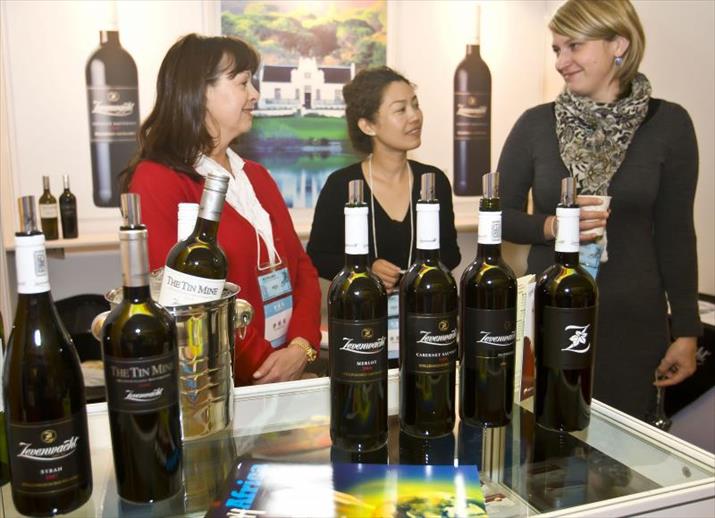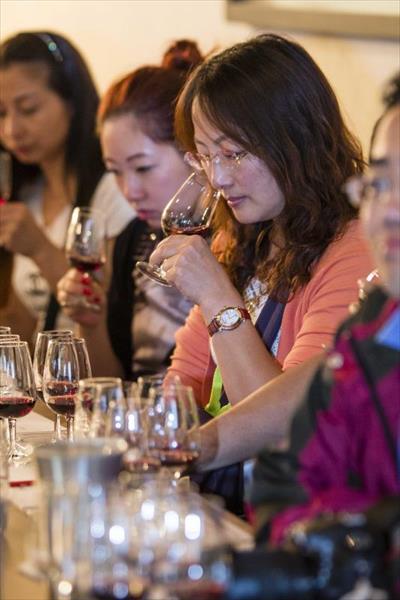|
||||||||||
| Home Nation World Business Opinion Lifestyle ChinAfrica Multimedia Columnists Documents Special Reports |
|
||||||||||
| Home Nation World Business Opinion Lifestyle ChinAfrica Multimedia Columnists Documents Special Reports |
| Africa |
| Grape Expectations |
| South African winemakers pursue multi-barrel strategy to become China's new toast |
| By Sudeshna Sarkar | VOL. 9 April 2017 ·2017-04-14 |

When Nondumiso Pikashe was teaching English and life orientation in a school in Cape Town, there was no place for wine in her life. Or that's what she thought. Her brother was an alcoholic and in her community, wine was regarded as something that created drunkards.
But a decade later, she is the co-owner of a vineyard where she teaches youngsters about the potential of winemaking as a lucrative career path and a step to strengthen national identity.
The change, as the 49-year-old told Destinyconnect.com in an interview last year, came from her curiosity about the dichotomy of wine: "In the media, wine was always projected as an iconic beverage of elegance but in my community, it was just looked down upon. I wanted to find out why."
Her curiosity led her to explore the industry and she was hooked, opening up a new world for black vintners, especially women. In 2006, after an earlier failed attempt, she set up her own winery, Ses'Fikile Wines, with three partners. Ses'Fikile is derived from Xhosa, one of the major languages spoken in South Africa.
"Loosely translated, it means 'we have arrived,'" Pikashe told ChinAfrica. "It is a multifaceted concept. It refers to the arrival of women in a space previously reserved for men to collaborate with them, the arrival of South Africa itself in the global arena to compete with other wine-producing regions."
Ses'Fikile makes three types of wines but is yet to get major retailers to sell them. Pikashe has been told that "black brands do not work." As an emerging black winemaker, she says the skepticism is due to "lack of recognition as a result of being non-players in the past in this space." It also means she has to struggle to find sustainable funding and support.
But Pikashe is optimistic about 2017. In March, Wesgro, the official tourism, trade and investment promotion agency for Cape Town and the Western Cape Province, brought a delegation of Chinese importers of South African wine to Cape Town so that they could meet black winemakers and learn about their labels.
"[Though] no memorandum of understanding has been signed yet, there are possibilities," Pikashe said. "I have been to China four times. I think this mission will be the culmination of my efforts to crack it."
While Ses'Fikile exports to Austria and is building its footprint in the Scandinavian markets, Pikashe's dream for 2017 is to find trading partners in six target markets: the EU, Angola, Kenya, Ghana and Nigeria in Africa, and China.
"South Africa and China are within the BRICS-fold. It then becomes a natural affinity to [export to China]," she said. "Statistics also indicate a growing demand for South African wine in China. Lastly, the South African-Chinese import and export relationship is skewed. We need to increase South African products in China."

An amazing discovery
The Chinese mainland has been an amazing discovery for the South African wine industry. In 2011, South African wine exports to China were below 5.5 million liters. But in five years it has nearly trebled, according to statistics from the Department of Agriculture, South African Directorate of Food Safety and Quality Assurance. At present, China is South Africa's sixth largest export market for packaged wines by volume, and the largest in the Asian region.
"The South African category in China grew exponentially in 2013-15," said Michaela Stander, Market Manager at Wines of South Africa (WOSA). "Many in the trade cited [it] as the surprise of 2015 as [South African wine] took up seventh position in terms of origin for imported wine."
While the top five export destinations for packaged South African wine are the UK, Germany, the Netherlands, Sweden, and the United States, Stander said China continues to grow in importance as an export destination, accounting for 3.7 percent of total exports in 2016 at 15.76 million liters.
"Some expected the South African category to decline somewhat in 2016, but instead we remained steady and are now in a position to overtake the United States for sixth spot," Stander added. "Across the world, we have noted a rising interest in South African wine as consumers are becoming more adventurous and keen to make new wine discoveries.South African wine is entering a new era."
Buoyed by the trend, WOSA, a non-profit created to promote South African wine in major export markets, opened an office in Hong Kong, China, in 2014. "Having a regional base means we can better capitalize on opportunities in the region. We can now more effectively support the growing number of South African wine companies trading in Asia, along with their importers, through increased education, networking and involvement in trade and consumer events," Stander said.
This year, the South African wine industry will have a substantial presence in promotional events in China. In March, Chengdu, a city in southwest China famed for its panda breeding and research center, hosted the "Great Wines of Southern Hemisphere 2017" trade show where South African vintners participated. On April 27, the "Discover South Africa" tasting event will be held in Shanghai. Stander said about 20 South African exhibitors will showcase over 200 types of wines.
In May, SIAL China, a major food exhibition in Shanghai, will see the South African Department of Trade and Industry (DTI) put up a national pavilion with the participation of winemakers. In October, WOSA will lead a three-city road show on the Chinese mainland. Finally, in November, South African wines will once again sparkle in ProWine China, an annual wine and spirit industry fair in Shanghai.

When in China
Located on the picturesque Stellenbosch wine route in the Western Cape, a prime tourist destination, Stellenbosch Vineyards is a 13-year-old company exporting its portfolio to 39 countries. The vineyard began to export to China from 2005, a year after its inception. It took part in the road shows in China last year and was back in March at the Chengdu promotion.
"We attended the road show to introduce our wines to local wholesalers and retailers who have an interest in buying from our agents," said Guy Kedian, Sales Manager at Stellenbosch Vineyards. "I found the level of interest and the level of wine knowledge very high. In China last year we sold around 80,000 bottles."
Stellenbosch Vineyards' production in 2016 was around 8 million bottles, bringing in nearly $13 million. The top three destinations were the UK, Netherlands and Denmark.
Kedian outlined the challenges for his company in China: the long distance, language barrier and the emerging wine culture in China which he said requires an appropriate approach. However, there are substantial opportunities as well, presented by a relatively untapped market with a large number of potential consumers and different consumer behavior, "which is more focused on authenticity and quality than on price alone."
To overcome some of these challenges, Stellenbosch Vineyards has modified part of its packaging and communication tools. More and more wineries are switching to Chinese labeling for China exports.
French wines have the lion's share of the Chinese market with 40 percent, according to 2016 estimates by grapewallofchina.com, a portal on Chinese wine and spirits. So to grow the market share, South African agencies are making an integrated effort. Various organizations, from WOSA to the DTI, South African Tourism and the Western Cape Government, are working together to create a unified South African experience. Wine tourism is an important part of this.
In 2016, South Africa received over 10 million international visitors, according to the Department of Tourism of South Africa. China was the leading growth market, with a 38 percent year-on-year growth. To woo this burgeoning market, South African vineyard areas have road signs in Chinese while restaurants are serving food preferred by Chinese tourists. South African tourism operators are learning Chinese and undergoing cultural immersion in China.
Partnering these developments are two specific government projects with a focus on China, said Yvette van der Merwe of South Africa Wine Industry Information & Systems.
Project Khulisa is a Western Cape government initiative which, among others, focuses on job creation and opportunities to improve the province's economy. Wine and brandy are a key segment in this strategy, and the government will assist exporters. China is a major destination market in this strategy.
WISE, a wine and brandy industry project, is intended to explore up to five individual markets in greater depth. China is the top market, followed by Angola and Nigeria in Africa, and the United States.
Comments to sarkarbjreview@outlook.com
|
||
| About Us | Contact Us | Advertise with Us | Subscribe |
| Copyright Beijing Review All rights reserved 京ICP备08005356号-5 京公网安备110102005860号 |